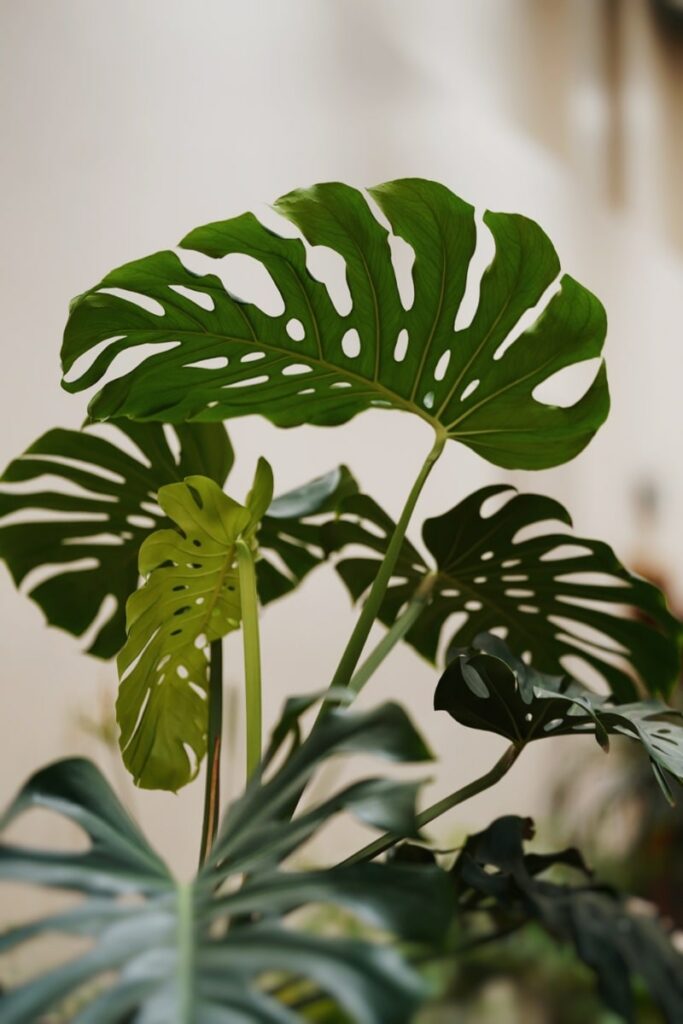Monsteras are a popular houseplant choice due to their striking appearance and hardy nature. These tropical plants hail from Central and South America and boast large, glossy leaves with intricate patterns and shapes. Their easy care and low maintenance make them a top pick for both novice and experienced plant owners alike. But did you know that there are several different types of Monsteras, each with their own distinct characteristics and features?
From the classic Monstera deliciosa to the rare and exotic Monstera adansonii, there is a Monstera variety for every plant lover out there. In this article, we will delve into the various types of Monsteras and what sets each one apart. Whether you’re a seasoned plant collector or just starting out, understanding the nuances among the types of Monsteras can help you select the perfect plant for your home or office.
Monstera Deliciosa
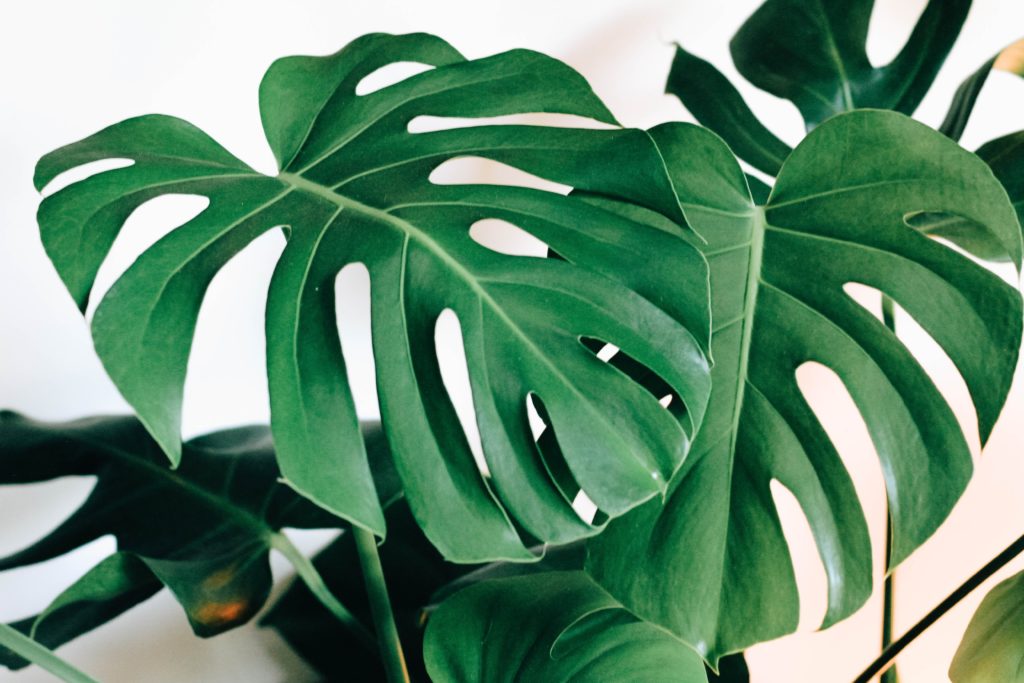
The Monstera Deliciosa, also known as the Swiss Cheese Plant, is a plant is the signature Monstera, and the starting point for many Monstera plant collections. Among the types of Monsteras we’ll explore, they are by far the easiest to purchase in a variety of sizes at the most reasonable prices.
When grown indoors, this all-green Monstera typically reaches a height of 6-8 feet. This plant is relatively easy to care for and can thrive in a variety of lighting conditions, although bright, indirect light is best – especially if you want it to form beautiful fenestrations on it’s large leaves.
Overall, the Monstera Deliciosa is a beautiful and versatile plant that is sure to make a statement in any setting. It’s low-maintenance and beauty make it a popular plant. We recommend starting with a Monstera Deliciosa before exploring more rare and expensive variants to perfect your care regimen.
Whether you’re a seasoned plant parent or just starting out, this plant is a great choice for anyone looking to add some greenery to their space.
Monstera Adansonii
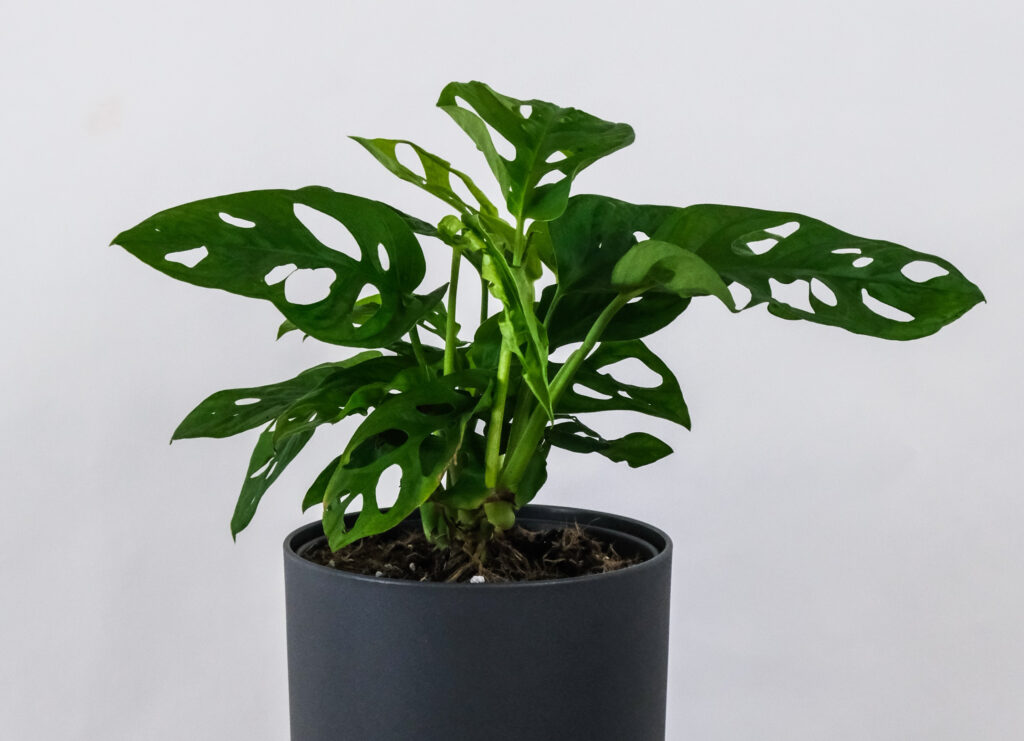
The Monstera Adansonii, also known as the Swiss Cheese Vine, is a plant that is highly sought after by plant enthusiasts. This is due to its unique foliage, which features small, heart-shaped leaves that are perforated with holes and have a lacy appearance. The plant is native to Central and South America, and it is a popular houseplant that is known for its aerial roots that can grow quite long and are used by the plant to climb and attach itself to nearby surfaces.
One of the most interesting things about the Monstera Adansonii is its ability to create a living plant wall. This makes it an excellent choice for those looking to add some greenery to their walls or create a living plant wall. The plant is relatively easy to care for, as it prefers bright, indirect light and well-draining soil. However, it is important to keep the soil moist but not waterlogged, as overwatering can lead to root rot.
When it comes to propagation, the Monstera Adansonii can be propagated through stem cuttings or by separating the plant at the roots. This makes it a great option for those looking to expand their plant collection or share their love of plants with friends and family. Overall, the Monstera Adansonii is a unique and beautiful plant that is sure to add some interest to any indoor space. Whether you’re a seasoned plant parent or just starting out, this plant is definitely worth considering for your collection.
Monstera Thai Constellation
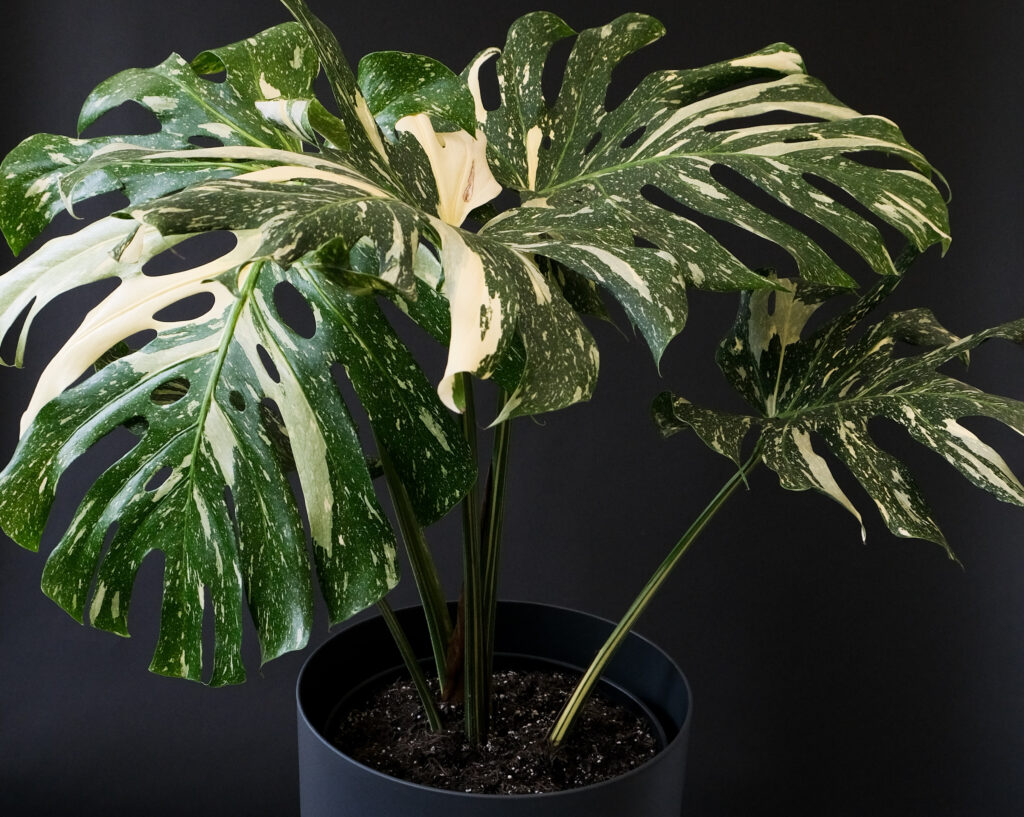
Thai Constellation Monstera is a unique variety of Monstera deliciosa, a popular indoor plant with large, glossy leaves that have iconic splits and holes. The Thai Constellation Monstera features variegated leaves with a mix of creamy white and green coloration, creating a stunning contrast that makes it stand out from other Monstera varieties. This plant is a cultivar developed in Thailand, and it is prized for its eye-catching appearance and relatively rare status, which makes it a sought-after addition to any plant collection.
The Thai Constellation Monstera has gained popularity among indoor plant enthusiasts due to its distinctive appearance and the challenge of cultivating it successfully. The variegation in the leaves of this plant is caused by a genetic mutation, which makes it less predictable and harder to propagate than other Monstera varieties. As a result, Thai Constellation Monstera plants tend to be more expensive and difficult to find than regular Monstera plants. Its stunning looks and stellar coloration make Thai Constellations the perfect types of Monsteras for collectors looking to add rarer plant varieties to their plant collection.
Monstera Albo
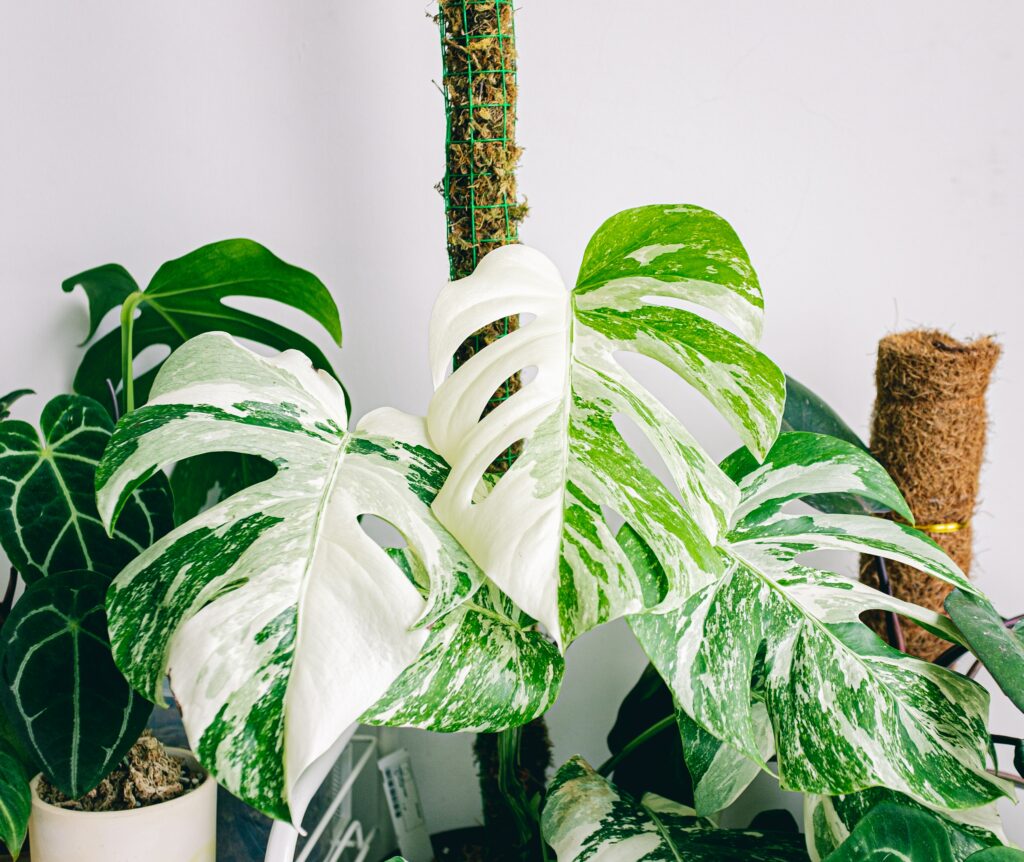
Monstera Albo is a cultivar of the Monstera deliciosa plant, also known as the Swiss Cheese plant. The Monstera Albo features unique variegated leaves with creamy-white patches, which contrast beautifully with the deep green color of the rest of the leaf. The variegation in the leaves is caused by a genetic mutation, which makes it rarer and more expensive than regular Monstera plants. Due to its striking appearance and relative scarcity, Monstera Albo has become a highly sought-after plant among indoor plant enthusiasts.
The popularity of Monstera Albo can be attributed to its stunning appearance, which adds a touch of elegance and style to any interior décor. The contrast between the creamy-white patches and the deep green color of the leaves creates a bold and dramatic effect, making it a statement piece in any room. Moreover, the Monstera Albo is relatively easy to care for, making it an ideal choice for plant lovers who want a low-maintenance yet beautiful plant. Its popularity has led to high demand, and it can be quite expensive to acquire, but its unique appearance and low maintenance requirements make it a must-have for many plant enthusiasts.
Monstera Dubia
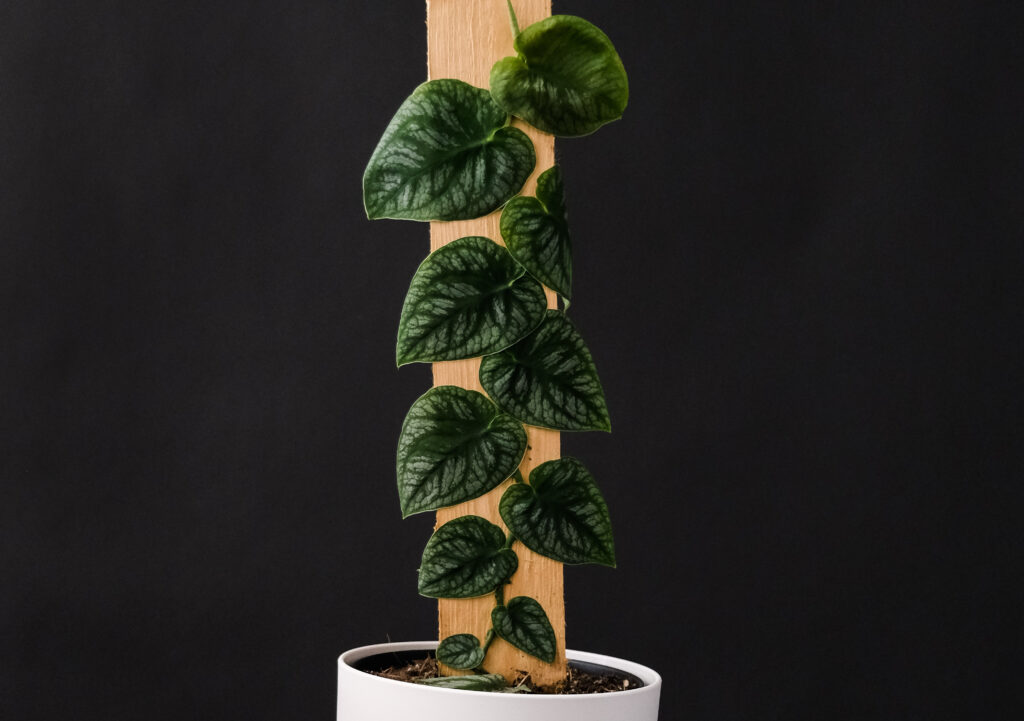
Monstera Dubia is a rare and unique plant that belongs to the Araceae family. It is a climbing plant that grows in tropical rainforests, particularly in South America, and is characterized by its small and delicate leaves. Unlike other Monstera species, the Dubia has leaves that are only a few centimeters in size, and they have a distinctive fenestration pattern that looks like tiny, irregular holes. The plant can grow up to six feet tall and has an elegant, slender stem. Due to its rarity and unique appearance, the Monstera Dubia has become a popular plant among collectors and indoor plant enthusiasts.
The Monstera Dubia’s popularity can be attributed to its distinctive appearance and the challenge of growing it successfully. The plant is relatively difficult to propagate and grow, requiring specific environmental conditions to thrive, such as high humidity and consistent warmth. The small and delicate leaves of the Dubia make it particularly susceptible to damage, and it requires careful attention to ensure its growth and development. Its rarity and unique appearance also add to its appeal, making it a prized addition to any plant collection. Despite its challenges, the Monstera Dubia’s striking beauty and elegance make it a popular and sought-after plant among collectors and enthusiasts alike.
Silver Monstera
Silver Monstera is a unique variety of the Monstera Deliciosa. This variant is known for its signature silver variegation, which appears as patches of white and silver-grey on the deep green leaves. The variegation in the Silver Monstera is caused by a genetic mutation, making it a rare and sought-after plant among indoor plant collectors.
The plant is relatively easy to care for, growing well in bright, indirect light and requiring moderate watering. It can grow up to ten feet tall and is commonly used as a statement piece in homes due to its striking and unusual appearance.
The popularity of Silver Monstera can be attributed to its unique and eye-catching appearance. The contrast between the silver variegation and the deep green color of the leaves creates a bold and dramatic effect that makes it a statement plant. Even better, the plant is easy to care for, making it an ideal choice for plant lovers who want a low-maintenance yet beautiful plant. Its rarity and unique appearance also add to its appeal, making it a prized possession among collectors and enthusiasts alike.
Split Leaf Monstera
The Split Leaf Monstera, ‘Philodendron bipinnatifidum,’ also known as the Selloum or Tree Philodendron, is a popular houseplant native to the rainforests of South America. It is known for its large, deeply lobed, and glossy leaves that grow up to three feet in length, and its impressive height that can reach up to ten feet tall in the right conditions. The Philodendron bipinnatifidum is a relatively low-maintenance plant that can thrive in a variety of light conditions, but it prefers bright, indirect light and moist soil. Its striking appearance and ease of care make it a popular choice among indoor and outdoor plant enthusiasts, and it can add a tropical feel to any living space or garden.
People love the Split Leaf Monstera for its impressive size and tropical appearance, making it an ideal statement piece in any room. Its glossy and deeply lobed leaves create a bold and exotic look that adds an instant touch of natural beauty to any space. Moreover, the plant is relatively low maintenance, making it an ideal choice for people who want to add a touch of greenery to their homes or gardens without the hassle of high maintenance requirements. Its ease of care and impressive size make it a must-have plant among indoor and outdoor plant enthusiasts, ensuring its popularity for years to come.
Mini Monstera
This list wouldn’t be complete without the Mini Monstera. Known scientifically as Rhaphidophora tetrasperma, this popular plant that is native to Thailand and Malaysia. It is known for its glossy green leaves that resemble the leaves of the Monstera deliciosa plant but are much smaller in size. This makes it a great pick for smaller spaces.
The plant is relatively easy to care for, requiring bright, indirect light and moderate watering. Its compact size and vining growth habit make it an ideal choice for small spaces or as a trailing plant on shelves or walls. The Rhaphidophora tetrasperma’s popularity can be attributed to its unique and beautiful appearance, ease of care, and compact size, making it a popular choice among indoor plant enthusiasts.
The Mini Monstera’s compact size and beautiful vining appearance make it a perfect choice for small apartments, offices, and rooms with limited space. It’s easy care requirements and ability to thrive in a variety of light conditions make it an ideal choice for beginners or those who have less time to devote to plant care. The Rhaphidophora tetrasperma’s unique and stunning appearance, coupled with its ease of care, make these plants the perfect types of Monstera for a growing rare plant collection.
Monstera Acuminata
Monstera acuminata, also known as the Shingle Plant or Shingle Vine, is a popular indoor and outdoor plant. Like many others on this list, it’s native to Central and South America.
It is known for its unique and distinctive leaves that grow flat against surfaces, resembling shingles on a roof. The plant is a slow grower and can take several years to reach its full potential, but it is relatively low maintenance and can thrive in a variety of light conditions. Its unusual appearance and ease of care have made it a popular choice among plant enthusiasts, and it can add a touch of exotic beauty to any living space or garden.
Its flat leaves grow horizontally against surfaces, creating an intriguing texture that adds depth and interest to any space. Moreover, the plant’s low maintenance requirements make it an ideal choice for people who want to add a touch of natural beauty to their homes or gardens without the hassle of high maintenance requirements.
A lot of people confuse the Acuminata for the Monstera adansonii. These plants are incredibly similar. The key difference is that the adansonii has larger leaves with bigger fenestrated holes within the leaves, while the acuminata grows smaller, narrower leaves with more fenestrated holes. The acuminata also sports a lighter green color compared with its darker adansonii cousin.
Monstera Obliqua
The Monstera Obliqua is a Monstera variant loved by collectors for its rarity and unique features. This climbing plant can reach up to 20 feet in height and boasts thin and delicate leaves that are characterized by large holes and irregularly shaped perforations. These leaves are smaller than those of other Monstera species, which only adds to their distinctiveness.
However, caring for the Monstera Obliqua can be quite challenging, as it requires high humidity and consistent moisture levels. This makes it a plant that is best suited for experienced plant owners who are willing to put in the extra effort to keep it healthy.
Despite its demanding nature, the Monstera Obliqua is a stunning and one-of-a-kind plant that is one of the most unique types of Monsteras collectors can add to a growing plant collection.
Monstera Esqueleto
Monstera Esqueleto, also known as the Skeleton Monstera, is a stunning Monstera variant. It’s known for its unique and unusual appearance, featuring delicate and intricate foliage that resembles a skeleton kept within beautiful bright-green foliage. It looks like a mix between the Monstera adansonii and the Monstera Obliqua.
The plant is a slow grower and requires a humid environment, but it is relatively low maintenance and can thrive in a variety of light conditions. Its striking appearance and ease of care have made it a popular choice among plant enthusiasts, and it can add a touch of tropical elegance to any living space or garden.
Monstera Pinnatipartita
The Monstera Pinnatipartita, a species of Monstera that hails from Central and South America, is a plant that is truly one-of-a-kind. Its leaves are deeply lobed and divided into several segments, giving it a striking and unique appearance that is sure to catch the eye of any plant enthusiast. These leaves can grow up to 12 inches long and 8 inches wide, making it a great choice for those looking to add a larger plant to their collection.
But that’s not all that makes the Monstera Pinnatipartita stand out. This plant also boasts aerial roots that grow from its stem, which can be used to anchor it to a support structure like a moss pole or trellis. This not only helps the plant grow taller, but it also adds to its overall aesthetic appeal.
Despite its unique appearance, the Monstera Pinnatipartita is relatively easy to care for, making it a great choice for beginners. It prefers bright, indirect light and well-draining soil, and benefits from regular watering. However, be sure not to overwater, as this can lead to root rot.
Overall, the Monstera Pinnatipartita is a plant that is sure to make a statement in any home or office. Its striking appearance and easy care requirements make it a great choice for plant enthusiasts of all levels.
Monstera Epipremnoides
The Monstera Epipremnoides, also known as the Philodendron Epipremnoides, is a rare and unique species of Monstera that hails from Central and South America. Its heart-shaped leaves are a sight to behold, with deep, narrow cuts and perforations that add to its distinctiveness.
This climbing plant can reach up to 20 feet tall in its natural habitat, thanks to its aerial roots that help it attach to trees or other structures. Its leaves are equally impressive, growing up to 12 inches long and 8 inches wide, with a glossy, dark green color that is sure to catch the eye.
But what sets the Monstera Epipremnoides apart is its ability to change its leaf shape as it matures. Young leaves are more rounded and have fewer cuts and perforations, while mature leaves become more elongated and develop deeper cuts and perforations. It’s a fascinating transformation that adds to the plant’s allure.
Finding the Monstera Epipremnoides can be a challenge, as it is relatively rare and not commonly found in nurseries or plant shops. But for those lucky enough to get their hands on one, it requires bright, indirect light and well-draining soil to thrive. Overwatering can lead to root rot, so it’s important to keep the soil moist but not waterlogged.
Overall, the Monstera Epipremnoides is a stunning and unique addition to any plant collection. Its distinctive leaves and climbing habit make it a standout plant that is sure to impress.
Monstera Standleyana
The Monstera Standleyana, also known as the Philodendron Cobra, is a plant that is native to Central and South America and belongs to the Araceae family. This climbing vine can grow up to 20 feet in height and is characterized by its elongated, heart-shaped leaves that are dark green in color and have a distinctive white or silver stripe running down the center of the leaf. The leaves are also slightly corrugated, giving them a textured appearance.
What makes the Monstera Standleyana so fascinating is its ability to change its leaf shape as it matures. Younger leaves are more elongated and narrow, while older leaves become more rounded and broader. This unique feature adds to the plant’s allure and makes it a standout in any collection.
Caring for the Monstera Standleyana is relatively easy, as it can thrive in a variety of lighting conditions, from bright, indirect light to low light. It prefers well-draining soil and should be watered when the top inch of soil feels dry to the touch. With proper care, this plant can be a long-lasting and beautiful addition to any home or office.
The Monstera Standleyana is a striking and unique plant that is sure to be a conversation starter.
Monstera Siltepecana
The Monstera Siltepecana, also known as the Silver Monstera or the Philodendron Silver, is a plant that is native to Mexico and Central America. It belongs to the Araceae family and is closely related to the Monstera Deliciosa and Monstera Adansonii. This climbing plant can grow up to 10 feet tall and has heart-shaped leaves that are dark green with silver markings on the veins. The leaves are also slightly velvety to the touch, which adds to its unique texture.
What’s fascinating about the Monstera Siltepecana is its ability to change its leaf shape as it matures. The younger leaves are more heart-shaped, while the older leaves become more elongated and have a more pronounced point at the tip. This feature makes it a popular choice among plant enthusiasts who appreciate the plant’s versatility.
Caring for the Monstera Siltepecana is relatively easy, and it can thrive in a variety of lighting conditions. It prefers bright, indirect light but can also tolerate lower light levels. Additionally, it prefers well-draining soil and should be watered when the top inch of soil feels dry to the touch.
Overall, the Monstera Siltepecana is a beautiful and unique plant that is sure to add a touch of elegance to any space. Its silver markings and changing leaf shape make it a popular choice among plant enthusiasts who appreciate the plant’s versatility and adaptability.
Monstera Karstenianum
The Monstera Karstenianum, also known as the “Peru Monstera,” is a fascinating plant variety that hails from Peru. This plant is a popular choice for indoor gardening due to its unique appearance and easy care requirements. The leaves of this plant are small and heart-shaped, with a glossy green surface and a velvety texture on the underside. The plant grows in a vine-like manner, with long stems that can reach up to 3 feet in length. The stems are thin and delicate, making them perfect for trailing over the edges of pots or hanging baskets.
One of the most distinctive features of Monstera Karstenianum is its patterned leaves. The leaves have irregular holes and perforations, which give them a lacy appearance. This pattern is similar to that of other Monstera varieties, but on a smaller scale.
Monstera Karstenianum is a relatively low-maintenance plant that thrives in bright, indirect light. It prefers well-draining soil and should be watered when the top inch of soil feels dry to the touch. This plant is also tolerant of a wide range of temperatures, making it a great choice for indoor gardening.
Overall, Monstera Karstenianum is a unique and beautiful addition to any indoor garden. Its small size and easy care requirements make it a great choice for beginners, while its distinctive appearance is sure to impress even experienced plant enthusiasts.
Borsigiana Variegata
The Borsigiana Variegata is a popular houseplant known for its beautiful variegated leaves. It is a variation of the classic Monstera deliciosa plant and is sometimes referred to as Variegated Swiss Cheese Plant.
The plant features large, heart-shaped leaves with striking variegation that can range from a creamy yellow to bright white. The Borsigiana Variegata is relatively easy to care for and can thrive in a variety of light conditions, making it a popular choice among indoor plant enthusiasts. Its striking appearance and low maintenance requirements have made it a highly sought-after plant, and it can add a touch of tropical beauty to any living space.
Monstera Peru
Monstera Peru, also known as Monstera Karstenianum, is a fascinating and distinctive species of Monstera that hails from the lush and verdant land of Peru. This plant is renowned for its small, heart-shaped leaves that are adorned with intricate and mesmerizing patterns of silver and green. Unlike other Monstera species, the leaves of Monstera Peru are much smaller, which makes it a popular choice for those who desire a more compact plant.
One of the most striking and remarkable features of Monstera Peru is its aerial roots. These roots grow out of the stem of the plant and can be trained to climb up a trellis or other support structure, making it an excellent choice for those who want to create a living wall or add some greenery to a vertical space.
Caring for Monstera Peru is relatively easy, as long as you provide it with the right conditions. This plant prefers bright, indirect light and well-draining soil, which allows it to absorb the nutrients it needs to grow and flourish. It also needs to be watered regularly, but not overwatered, as this can lead to root rot and other problems.
Overall, Monstera Peru is a stunning and unique addition to any plant collection, and one of the most popular rare types of Monsteras. Its small size and intricate patterns make it a popular choice for those who want a more compact Monstera, while its aerial roots make it a great choice for those who want to create a living wall or add some greenery to a vertical space. Whether you’re a seasoned plant enthusiast or a novice gardener, Monstera Peru is one of the most unique types of Monsteras to add to your collection.
Monstera Variegata Mint “Mint Monstera”
One of the newest variegated types of Monsteras is the Monstera Variegata Mint. It’s a rare and highly sought-after houseplant known for its stunning variegated leaves with a mint green coloration. This plant is sometimes confused with the Monstera Thai Constellation. The key differences between the two plants is that the Variegata Mint features smaller speckled patterns uniformly shared across the plant’s leaves, while the Thai Constellation has larger, splotchy patterns mixed with all-cream segments.
The Variegata Mint is a variation of the classic Monstera deliciosa plant and is sometimes referred to as the Mint Monstera. The plant features large, heart-shaped leaves with unique variegation that can range from a creamy white to a light mint green. The Monstera Variegata Mint is relatively easy to care for and can thrive in a variety of light conditions, making it a popular choice among indoor plant enthusiasts. Its unique and striking appearance, coupled with its rarity, have made it a highly coveted plant, and it can add a touch of tropical elegance to any living space.
Due to its newness and rarity, the Monstera Variegata Mint is one of the rarest types of Monsteras, and is highly sought after by collectors, further adding to its popularity and demand.
Choosing the Right Plant Among the Types of Monsteras
With so many different types of Monsteras available, it can be overwhelming to choose the right one for your home. However, fear not, as by understanding the characteristics of each type, you can make an informed decision that will suit your needs and preferences.
When it comes to choosing a Monstera, there are a few factors to consider. First, you need to think about the amount of space you have available. If you have limited space, a smaller variety like the Monstera adansonii or Monstera siltepecana may be a better fit. Second, you need to consider the lighting conditions in your home. If you have a bright, sunny spot, the Monstera deliciosa or Monstera obliqua will thrive. Lastly, you need to think about your level of experience with plant care. If you are new to plant care, a hardy variety like the Monstera adansonii or Monstera deliciosa may be easier to care for.
But it’s not just about practicality, it’s also important to consider the aesthetic qualities of each type of Monstera. The Monstera deliciosa is a classic choice with its large, split leaves, while the Monstera obliqua is a more unique option with its delicate, perforated leaves. The Monstera adansonii and Monstera siltepecana both have smaller, more compact leaves that can add a touch of greenery to any space.
Ultimately, the types of Monsteras for you will depend on your personal preferences and the conditions in your home.
Frequently Asked Questions
What are the Different Types of Monsteras?
There are many different types of Monsteras, whether they are sub-species related to the Monstera Deliciosa, or genetic variants that add stunning variegated leaf and stem patterns. From long vines to large leaves, there is a Monstera for every avid plant collector.
What is the difference between Monstera Deliciosa and Monstera Adansonii?
Monstera Deliciosa has larger leaves with distinct splits and holes, while Monstera Adansonii has smaller leaves with more intricate splits and holes. Monstera Deliciosa is also known as the “Swiss Cheese Plant” and is more commonly found in households.
What is Monstera Obliqua?
Monstera Obliqua is a rare and highly sought-after species of Monstera. It is known for its delicate, fenestrated leaves and is often referred to as the “Swiss Cheese Vine.” Due to its rarity, it is difficult to find and can be quite expensive.
What is Monstera Borsigiana?
Monstera Borsigiana is a smaller and more compact version of Monstera Deliciosa. It is often referred to as the “Mini Monstera” or “Monstera Ginny” and is a popular choice for indoor gardening due to its manageable size.
Can Monsteras be grown indoors?
Yes, all types of Monsteras can be grown indoors as long as they are placed in a bright, indirect light and are not overwatered. They are a popular choice for indoor gardening due to their unique and attractive foliage.
How do I care for my Monstera?
All types of Monsteras prefer bright, indirect light and well-draining soil. They should be watered when the top inch of soil is dry and should not be overwatered. Fertilizing once a month during the growing season can also help promote healthy growth.

